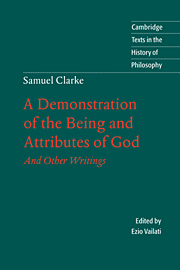Introduction
Published online by Cambridge University Press: 07 January 2010
Summary
The sixteenth and seventeenth centuries saw the reoccurrence in western thought of methods and procedures in the study of the natural world which had been largely forgotten or not systematically used since Archimedes. The reawakening of western science was so fast and momentous as to be truly revolutionary. Especially in physics, the new science centered on the mathematization of nature, a process which accelerated as more and more powerful mathematical tools, from analytic geometry to calculus, were developed.
The relation of modern science to traditional religion soon proved problematic. Some natural philosophers, e.g., Galileo Galilei (1564–1642), thought that the new science was incompatible with a literal reading of the Scriptures; others, for example, Benedictus de Spinoza (1632–77) and Thomas Hobbes (1588–79), believed that it was in conflict with many of the traditional tenets of natural religion, and consequently were considered, perhaps somewhat unjustly, atheists by their contemporaries. However, many of the natural philosophers involved in the scientific revolution thought that religion or, at a minimum, natural religion, and the new science could be made compatible once the philosophical ramifications of modern science were properly understood.
The first great systematic attempt to harmonize religion and modern science was carried out by René Descartes (1596–1650), who produced a metaphysical system in which a perfect God exists, the soul is immaterial and immortal, and matter, being nothing but tridimensionally extended substance, is the proper subject of mathematization. However, Descartes' system soon ran into difficulties.
- Type
- Chapter
- Information
- Samuel Clarke: A Demonstration of the Being and Attributes of GodAnd Other Writings, pp. ix - xxxiPublisher: Cambridge University PressPrint publication year: 1998
- 4
- Cited by

